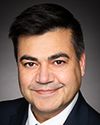Thank you so much.
Good afternoon, everyone. Thank you so much for having me here today to participate in this very important discussion about the long-term impacts of pay gaps experienced by differing genders and equity-seeking groups among faculty at Canadian universities.
My name is Indira Naidoo-Harris. I'm the associate vice-president of diversity and human rights at the University of Guelph. I'm also a former Ontario MPP, as well as Ontario's first-ever minister of the status of women. I was also the minister for education and for early years and child care. Therefore, for me, gender pay inequity is not a new topic or a recently discovered problem; it's a decades-long, systemic inequality that continues to have harmful impacts on our society, economy and workforce.
Before we begin, I would like to acknowledge that the University of Guelph is situated on the treaty lands and territories of the Anishinabe, the Haudenosaunee and the Mississaugas of the Credit.
I'd like to start by giving you some details about my background to provide some context.
As minister of the status of women, I drove the women's economic empowerment strategy, which aimed to increase gender equity, challenge bias and eliminate barriers that women face at work and in their communities. As minister responsible for early years and child care, I worked to help remove one of the biggest barriers to gender pay equity in Ontario: accessible and affordable child care.
At the University of Guelph, I work with students, faculty, staff, and senior administration to foster a culture of inclusion by leading education, discussion and cultural change efforts in inclusivity, equity, accessibility and human rights. My work also includes ensuring fair and expeditious issue resolution within the university community. I sit on several advisory boards, including the university's gender equity advisory group.
Pay inequities at Canadian post-secondary institutions have been studied for decades. However, while the gap has, indeed, shrunk, it still rests at women earning close to 10% less than men for the same work. The Canadian Association of University Teachers says that this number is even starker for racialized faculty. This is unacceptable and has to change.
Interestingly enough, according to the Higher Education Quality Council of Ontario, we're at a point in time now where women have made substantial gains in education. They are more likely than men to attend post-secondary institutions and to perform better academically, and they are often more engaged in campus life. However, as those women move through the academic pipeline, they wind up lagging behind and are under-represented in the senior ranks of academic faculty.
In fact, according to data released by StatsCan in January of this year, in Canada only 31.4% of women are full professors. In one study done by King's University College, it was determined that, across a decades-long career and retirement survey, there was a cumulative pay and pension gap of $454,000 at the associate level and $468,000 at the full professor level.
Now consider those numbers in tandem with the harsh impact that the pandemic has had on gender and racialized women in the workforce. For example, according to the United Nations, across every area women and girls were hit hardest by the pandemic, and McKinsey reported that women's jobs were close to 1.8 times more vulnerable during the COVID-19 crisis.
Considering that women are some of the world's most powerful consumers and also play a huge role in our communities, it's crucial for economic growth and for building sustainable and fair communities that we work out how to get this right.
In 2017, the University of Guelph underwent a faculty salary anomaly review, with a focus on gender equity. The review at the University of Guelph resulted in an across-the-board increase of $2,050 for every full-time faculty member who identified as a woman or as non-male. It affected more than 300 tenure-track and contract faculty with appointments of more than two years. This effort was part of a multi-phase gender equity initiative to bring community members together to discuss and shape gender equity at the institution. It involved research and identifying opportunities for change. The University of Guelph is currently undergoing a second salary anomaly review, and it will be interesting to see what effect COVID-19 has had on pay equity.
The pay equity gap that we are seeing today continues for a number of reasons: biases determining starting salaries and merit pay, differing rates of promotion, unconscious biases in the hiring process, and the effects of parental care and caregiving leaves.
When we evaluate female and racialized candidates and their experiences, we have to ask if we are looking at the biases in our metrics. Do we acknowledge that female and racialized candidates receive shorter and more vague reference letters, and aren't quoted or published as frequently as their male counterparts?
Regarding the wage gap—










